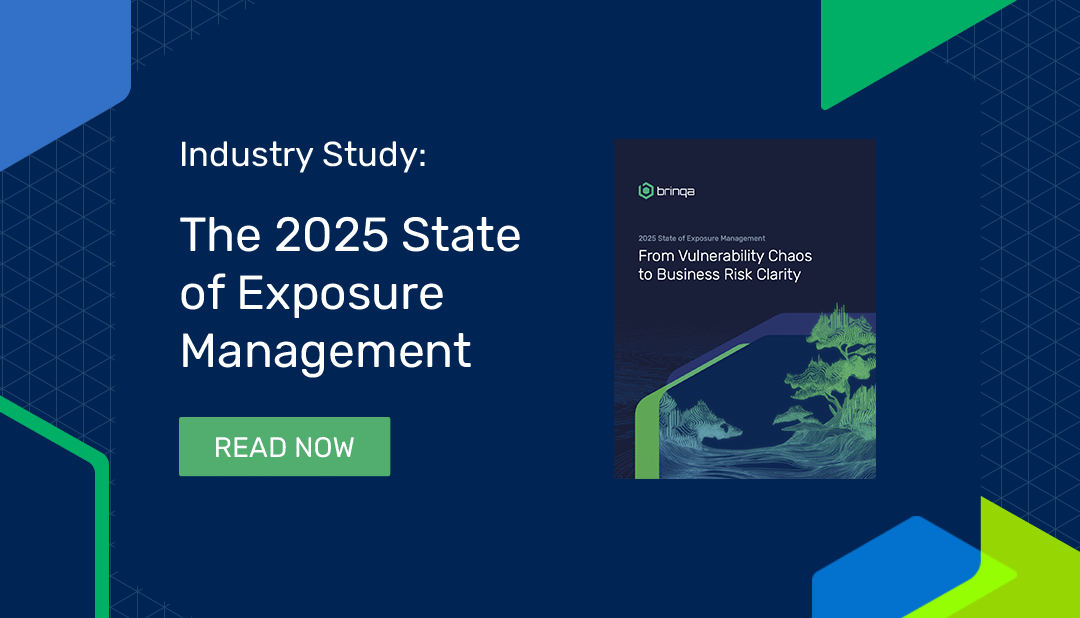
Build vs. Buy: Choosing the Right Path for Unified Vulnerability and Exposure Management

For large enterprises with strong engineering talent and deep technical resources, building your own internal unified vulnerability and exposure management platform can seem like a logical path. After all, who knows your environment better than your own team? With the right developers, data scientists, and DevSecOps support, why not build a custom system tailored exactly to your organization’s needs?
But for many security leaders who try this route, the reality sets in fast: integration fatigue, mounting maintenance costs, a long-term support and ownership burden, delayed time to value, and platforms that can’t scale with business demands. At Brinqa, we regularly talk to Forbes Global 2000 companies that have tried to build before deciding to buy. Here’s what we’ve learned from those conversations—and why so many security leaders ultimately choose to partner instead of build.
The Appeal of Building In-House
Let’s be honest: building your own vulnerability management system sounds empowering. It promises:
- Full control over architecture and data
- Integration into your internal stack
- Custom workflows tuned to your processes
- Flexibility to evolve as your organization grows
While it might seem like your security engineering team has the skills to build a custom solution, there’s a critical distinction between writing tactical automation scripts and developing enterprise-grade, future-proofed platforms. Most homegrown efforts start as promising prototypes but quickly run into technical debt, scalability issues, and growing dissatisfaction.
What to Consider Before You Build
Before committing to an internal build, ask:
- Do you have the right development resources?
Not just security engineers, but a dedicated software development team with architectural oversight and platform engineering experience—not just scripting or tactical automation. - Is this the best use of those resources?
Even if you have the talent, is building non-core infrastructure the most strategic investment? Redirecting engineers away from revenue-generating or differentiated initiatives can hurt long-term competitiveness. - Can you commit to long-term maintenance and continuity?
Internal builds require sustained investment—not just in initial development, but in maintaining integrations, fixing bugs, and updating features—despite turnover, shifting priorities, or budget cycles. - Are you prepared for the integration burden?
Supporting dozens of evolving tools—scanners, CMDBs, cloud platforms, ITSM systems, threat intel feeds—means keeping up with API changes and potentially building custom adapters and API kits. - Can you evolve with the threat landscape and industry innovation?
Risk scoring models (like EPSS), automation strategies, and threat intel are advancing rapidly. Will your platform adapt fast enough? - Have you planned for reporting and stakeholder engagement?
If reporting is in scope, will the system support dashboards tailored to multiple audiences—security, compliance, engineering, executives? - Can you meet modern software and supply chain security standards?
Internally built systems still need to follow secure development practices, track dependencies, and meet enterprise-grade security expectations.
Most organizations that answer these questions honestly recognize the operational and strategic overhead of building outweighs the perceived flexibility or control.
7 Reasons Internal Builds Fall Short
The lack of dedicated, ongoing commitment and investment in professional enterprise development is a key reason internal builds fall short. Without scalable architecture, secure design, rigorous testing, and long-term support, these tools often remain brittle prototypes that can’t keep pace with evolving business needs.
This leads to seven common challenges that organizations encounter when internal projects fail to deliver:
- Integration Burden
Vulnerability management is a data integration problem at scale. Maintaining large sets of constantly evolving connectors—for scanners, CMDBs, ITSM tools, threat intel feeds, cloud platforms, and more—requires dedicated engineering time and constant vigilance. Every vendor API change becomes a fire drill. - Incomplete Prioritization
Homegrown systems often rely on static CVSS scores or spreadsheet logic. Without unifying technical findings with business context (asset criticality, exposure, ownership, compensating controls), you’re just generating more noise, not insight. - Delayed Time to Value
Most internal builds take 1-2 years to stabilize—and by then, the business and threat landscape have already moved on. Compare that to months, not years, to realize value from a platform like Brinqa. - Limited Workflow and SLA Automation
Configurable automation for ticket creation, ownership assignment, remediation validation, and SLA tracking is hard to replicate internally. Without it, accountability and speed suffer. - Scalability Constraints
From millions of vulnerabilities to hundreds of data sources, the scale of enterprise security data is staggering. Most internal systems buckle under volume or require constant tuning to stay afloat. - No Support, No Roadmap
With internal builds, your team owns the bugs, the uptime, the roadmap, and the feature backlog. There’s no SLA. No partner to lean on. Just you and the workload. - Compliance Nightmares
As with any internal software build, a unified vulnerability management solution would need to be built according to software development standards and supply chain security practices. Homegrown tools may not be able to stand up in a compliance audit.
Build vs. Buy: A Side-by-Side Evaluation
| Category | Build | Buy (Brinqa) |
|---|---|---|
| Time to Value | 1-2 years | Months |
| Upfront Cost | High (FTEs, infrastructure) | Predictable subscription |
| Long-Term Maintenance | Internal team | Vendor-managed |
| Scalability | Often limited | Proven at 50M+ findings |
| Customization | High but labor-intensive | High, without code |
| Automation & SLAs | Hard to implement | Built-in and configurable |
| Support & Roadmap | In-house only | Enterprise-grade support |
Let’s Talk About Costs: Project vs. Program
Many organizations think of internal builds as one-time projects. But building a vulnerability management platform is not a “set it and forget it” effort—it’s the beginning of a long-term program. You’re committing not just to writing code, but to product management, architectural planning, integration maintenance, stakeholder support, documentation, roadmap execution, and ongoing innovation.
To illustrate, let’s zero-in on costs:
| Project Build | Program Buy |
|---|---|
| Engineering salaries | Subscription/license costs (annual) with included support |
| Project management (initial + ongoing) | Onboarding (one-time) |
| Infrastructure (hosting, backups, security) | |
| Maintenance and updates | |
| Hidden costs: delays, bugs, compliance audits |
The biggest cost? Distraction.
Security teams end up managing development projects instead of managing threats. Internal development teams focus on plumbing—APIs, data normalization, dashboards—instead of strengthening and scaling the organization’s core security competencies.
That opportunity cost grows over time: instead of investing in automation, remediation speed, or risk-based prioritization, you’re investing in infrastructure that already exists off the shelf.
What Best-in-Class Vulnerability Management Looks Like
The gold standard of modern vulnerability and exposure management is far more than a scanner and a spreadsheet. Enterprise programs need:
- A unified view across on-prem, cloud, applications, and assets
- Contextual scoring based on exploitability, exposure, and business impact
- Seamless integration with remediation workflows in ServiceNow, Jira, Azure DevOps, and more
- Auto-ticketing, SLA enforcement, and suppression of noise
- Role-based dashboards and real-time board reporting
These capabilities are difficult (and costly) to build internally—but standard in a platform like Brinqa.
Why Buying Makes Sense for Enterprise-Scale Programs
The Brinqa vulnerability and exposure management platform was built to solve the problems that homegrown tools struggle with:
- Pre-built connectors to hundreds of scanners, cloud platforms, and ticketing tools
- Support for dynamic scoring models like EPSS, exploitability, and asset context
- Enterprise-grade automation frameworks for routing, tracking, and SLAs
- Proven scalability (50M+ vulnerabilities under management)
- Configurable dashboards and board-ready reporting
With Brinqa, security teams can unify, contextualize, and act on vulnerability data at scale—without having to build the backbone themselves. For you, that means faster results and less risk at a predictable price point.
Case in Point: Nestlé and PhonePe
Nestlé initially considered building a custom vulnerability management platform. But once they discovered Brinqa, they realized they could meet their needs faster and more effectively by buying. Today, they use Brinqa to consolidate vulnerabilities across global operations, enrich findings with business logic, and automate risk-based remediation at scale.
PhonePe had the resources to build. But as their security team put it: “We didn’t want to be in the business of building and maintaining a platform. We wanted to focus our energy on building a world-class application security program.”
Preparing for What’s Next
Security programs are evolving fast—and the platforms that support them need to evolve too. AI-driven remediation, automated decisioning, and dynamic risk analytics are reshaping how organizations manage cyber risk.
Forward-looking teams are investing in platforms that:
- Enable AI agents to act on enriched, prioritized vulnerability data
- Feed Copilot, PowerBI, and other downstream systems via API
- Automatically flag exposures based on real-world exploitability and business value
- Are composable, flexible, and ready for new data sources
Building a platform for today is one thing. Building for tomorrow is another. Brinqa gives you both.
Where Do You Want Your Team Focused?
- Building a platform—or reducing time to remediation?
- Maintaining brittle connectors—or orchestrating auto-patching at scale?
- Manually formatting reports—or enabling board-ready dashboards?
Security leaders don’t choose Brinqa because they can’t build. They choose it because they have bigger problems to solve.
Still deciding how to implement your UVEM strategy? See how manual, bolt-on, build-your-own, and platform approaches compare
Ready to focus your security team on what matters most? Request a demo to see how the Brinqa platform helps enterprise teams unify, prioritize, and remediate risk at scale.
Frequently Asked Questions (FAQ)
What is a unified vulnerability management platform?
A vulnerability management platform is a software solution that helps organizations identify, prioritize, and remediate security vulnerabilities across IT, cloud, and application environments. These platforms integrate with scanners, asset inventories, threat intelligence, and ticketing systems to streamline risk-based decision-making.
Should large enterprises build or buy a vulnerability management solution?
Large enterprises often consider building their own platform to meet unique requirements. However, many choose to buy due to the complexity of integrations, the need for scalability, and the time and cost involved in long-term maintenance. Buying often results in faster time to value and access to proven capabilities like automated prioritization and SLA enforcement.
What are the disadvantages of building a unified vulnerability management platform in-house?
Disadvantages include:
- High ongoing engineering costs
- Fragile integrations that break with vendor API changes
- Difficulty scaling to millions of findings and dozens of data sources
- Lack of dedicated support or roadmap
- Slower response to evolving threats and technologies
How do vulnerability management platforms prioritize vulnerabilities?
Modern platforms use risk-based prioritization models that go beyond CVSS scores. These models incorporate business context (e.g., asset criticality), exploitability signals (e.g., EPSS), threat intelligence, and exposure data to identify which vulnerabilities pose the highest risk to the organization.
What features should I look for in a vulnerability management platform?
Key features include:
- Support for multiple scanners and data sources
- Highly customizable risk-based scoring and prioritization
- Integration with ticketing and remediation workflows
- Dashboards and reporting for executive visibility
- Automation for SLA tracking, deduplication, and noise suppression
How long does it take to build an internal vulnerability management solution?
In most cases, internal builds take 1-2 years to reach maturity—and often require continuous investment in engineering, DevOps, and product management. Many organizations find that business needs and tech stacks evolve faster than internal tools can keep up.
What is the total cost of ownership (TCO) for a homegrown vulnerability management system?
TCO includes salaries for engineers, product managers, and support staff; cloud infrastructure costs; time spent maintaining integrations; and opportunity cost from delaying remediation or reporting, plus hidden costs such as delays, bugs, and compliance audits. For large organizations, this can exceed $2 million annually.




